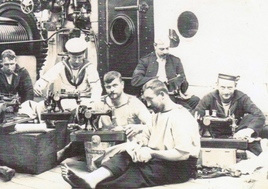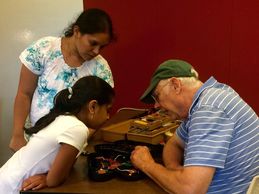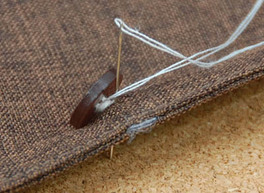|
Tinkering. Being handy. Repair manuals. The town repairman. Valuing well-made belongings. These classic values and skills suffered in rise of the “cheap and disposable” culture. People forgot how to tinker, and even lost the urge to fix. But it’s making a big comeback! Read on to find out the joys and importance of fixing things.

Why fix?
We bet you have your own reason(s) for wanting to repair things. Here are some reasons we love fixing.
Fixing supports what you care about. Such as keeping boots that fit you perfectly. Supporting local businesses. Conserving natural resources. Whether it “costs” more to fix something depends on what you value.
Fixing is fun and rewarding. If you haven’t tried it, you just don’t know how great it feels when you repair something yourself. Not only will you feel pretty darn good about yourself, you may also be surprised to find that you feel more attached to the lamp, or toaster, or laptop. And we bet you’ll be looking forward to your next fix.
Fixing and reuse are sustainable consumption. Fixing things is a way to push back against disposable culture and over-consumption. If we can satisfy even a portion of our needs by fixing and reusing things we already have rather than buying new things, then we move towards consuming sustainably. Check out ifixit.org to find out more about the benefits of fixing.
Fixing creates jobs. MPCA recently reported that the state’s repair, reuse, and rental sector includes 45,500 direct jobs, and 32,000 more indirect jobs to support the sector's businesses. For comparison, Minnesota’s mining sector ads about 28,000 jobs.
Fixing is frugal. “When we needed a new computer, we decided to go with a refurbished computer instead of a new one. It has worked as well as any new item I’ve ever purchased but was quite a bit cheaper." – Cheryl Savtaski
Fixing builds community and is intergenerational. One visitor to a fix-it clinic said: “Thanks so much! It is wonderful to have an item you like be fixed rather than thrown away. You are the greatest!"
Things fall apart. Plan for that. Over time, things weaken, break, and wear out. So it’s important that when you do buy something, you ask up front about its repairability.
|

How to Fix?
Have someone else fix it
If you just want it fixed, the great repair shops of Minnesota are here to help. There are too many repair shops to mention, so before you throw something out, check online to see if there’s a repair option near you.
You can find shoe/leather repair, seamstresses, electronic repair, small engine and outdoor gear repair stores – strollers, tents, coats, boots, and more. There are wicker repair shops, furniture repair and reupholstery shops, and lamp repair shops.
Often places that sell goods have a repair arm as well. Hardware stores often repair window screens and sharpen knives, scissors and skates. REI and Best Buy offer some repair services. Many other national brands, like Patagonia, LL Bean, and others will repair items they manufactured for a fee.
|

Have someone teach you
What if there was a place where 70-85% of the broken things that came in, left fixed, with no labor charges? There is! In the last few years, Fix-it Clinics have taken off.
Several counties now offer free community events, where helpful volunteer fixers work with you to diagnose and fix your “small enough to carry” items. Small electronics, appliances, textiles are all generally allowed. Think vacuum cleaners, radios, toasters, microwaves, lamps, ceramics, coats, pants, drapes, jewelry, etc.
"I brought in a lamp that my mother-in-law bought 50 years ago—used," said Dick Borchert, who came to a Coon Rapids fix-it clinic.
"I didn't know how to fix it. But in a half hour, Gary got it working."
Dakota, Hennepin and Ramsey Counties all are holding Fix-it Clinics in 2016. Minneapolis, Rochester and Andover have also tested the waters of hosting clinics in their cities. Could you hold one in your area?
“It’s not just drop it off like at a repair shop, and then you have no idea what happened. The idea is that you take ownership of your stuff and learn how to take stuff apart, troubleshoot it and then, hopefully, learn how to fix it,” said Nancy Lo, Hennepin County Fix-it Clinic Coordinator.
|

Do it yourself
If you’re handy, you can fix things yourself. The internet is chock full of on-line tutorials, open source how-to manuals, and videos that will walk you through the process.
There are store and online spaces for parts for just about anything, including your dad’s turntable you’d love to have working again. Or you can ask for advice: “When I told the woman at the sewing and craft store I was trying to patch my kids’ pants, she explained just what I’d need and showed me how to do it," said Madalyn Cioci.
Ifixit.com is an example of an open source community of free online repair guides. People have documented how they fixed things, and shared that information with pictures and instructions.
Find out more, and start repairing
|
6th Annual Sustainability Film Series. We Are All Related Here, Thursday March 3rd, 6:30PM – 9:00PM, Bell Museum of Natural History, Minneapolis. All films are free to University of Minnesota students, staff, and faculty and included in admission to the Bell Museum for others.
We Are All Related Here is a documentary experience inside the Yup’Ik Native American community in Newtok, Alaska and their struggle and resolution in the face of the impact of climate change. They face the ramifications of erosion and flooding and the possibility of moving their entire community. What does that mean to them and for us?
Fix-It Clinics. Get household items fixed for free and learn valuable repair skills at an upcoming Fix-It Clinic. Residents can bring small household appliances, clothing, electronics, mobile devices and more to receive free guided assistance from volunteers with repair skills to disassemble, troubleshoot and fix their items. Fix-It Clinics teach troubleshooting and basic repair skills, build community connections and reduce the number of repairable objects that are thrown in the trash.
-
Hennepin County Fix-It Clinic - Saturday, March 12, noon to 4 PM., Interfaith Outreach & Community Partners, Plymouth.
-
Dakota County Fix-It Clinic - Saturday, March 19, noon to 4 PM., Inver Glen Library, Inver Grove Heights.
-
Ramsey County Fix-It Clinic - Saturday, March 26, 12:30PM to 3:30 PM, Merriam Park Library, St. Paul.
Minnesota Warming. Saturday March 5th, the Minnesota Center for Environmental Advocacy (MCEA) and Climate Generation are hosting an event to raise awareness for climate change in Minnesota.
From 1:00-3:00 p.m., young professionals are invited to participate at Theodore Wirth Park in outdoor activities (weather/climate permitting), followed by a discussion forum at Lakes & Legends Brewery in Minneapolis from 3:30-5:00 p.m. FREE Equipment Rentals at Theo Wirth Park, and FREE Beer from Lakes and Legends (Limit 1, 21+). Register by Monday, February 29th. Registration limited to the first 100 attendees.
Fully Charged: Can Minnesota transition to electric buses? Wednesday, March 30, 7:00-8:30 AM. Town and Country Club, 300 N Mississippi River Blvd, St. Paul, MN 55104. Registration fee for Fresh Energy members, government employees, and students is $30; general admission is$45. Register online.
Proterra, the country’s largest electric bus manufacturer, has a goal to move bus fleets away from fossil fuels to electric vehicles. Join Fresh Energy for a conversation with Matt Horton, vice president of sales and marketing for Proterra, and Shawntera Hardy, deputy chief of staff for Governor Mark Dayton, to explore why and how Minnesota communities can transition to electric buses and what it will take to get there.
Thank you for reading Living Green 365. This newsletter is a publication of the Minnesota Pollution Control Agency. Please send questions or comments about living green to the address below.
Sincerely,
Erin Barnes-Driscoll and the Living Green Team
livinggreen365.pca@state.mn.us
|